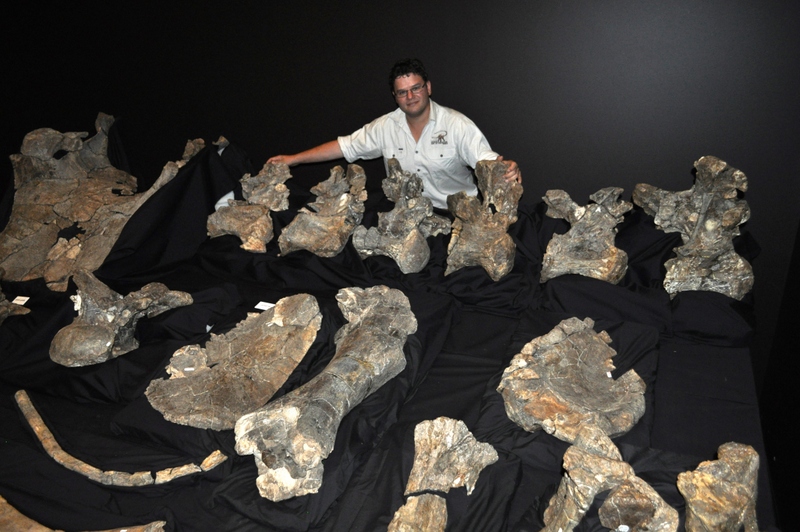Savannasaurus
Stephen Poropat and Savannasaurus elliottorum
By Stephen Poropat
In October 2016 a new Australian dinosaur was announced to the world. It was yet another example of how slowly scientific wheels turn. The first bones of S.elliottorum, or "Wade" as he is affectionately known by his close friends, were discovered eleven years ago and it has taken all this time to get him ready for his debut. Senior author of the paper, Dr. Stephen Poropat, has generously taken the time to write a personal account of how he first met Wade and of his ongoing relationship with this iconic dinosaur. Steve is well known to Dinosaur Dreaming. He first became involved as a 15 year old work experience student in the Paleolab at Monash University, going on to do his undergraduate degree there and attended a number of the annual Dinosaur Dreaming digs at our Inverloch site. Steve then went on to do his Masters and PhD at Monash University before accepting a part-time post-doctorate position at Uppsala University in Sweden. It was during this time that he was introduced to David Elliott and the Australian Age of Dinosaurs at Winton in Queensland, where he was given the opportunity to study this amazing animal from Australia's past. Details of the paper are listed below.
Wade's story by Stephen Poropat:
I visited the Australian Age of Dinosaurs Museum (AAOD) in Winton, Central West Queensland for the first time in October 2010. It must have been on that first trip that I became aware of the existence of a dinosaur nicknamed "Wade". "Wade" was found in 2005 by AAOD co-founder David Elliott while he was mustering sheep. The bones of this sauropod were exhumed in 2005 by a combined AAOD-Queensland Museum team (led by Alex Cook and Scott Hocknull), and the specimen was nicknamed after the late Dr Mary Wade, a staunch supporter of AAOD and former Queensland Museum curator. From 2005 onwards, the bones of "Wade" were continually worked on in Winton by volunteers and staff alike. When I visited in 2010, little had changed: "Wade's" bones were still being prepared! As soon as one specimen was finished, it was cloistered with the rest of the "Wade" bones in the nondescript, securely locked "Wade Container", to which few people were allowed access.
I do not recall the precise timing of my first sneak peek inside the "Wade Container", but whenever it happened I was figuratively blown away. Shelves filled with vertebrae, limb bones and ribs lined each side, but the pièce de résistance was at the far end: the undercarriage of "Wade's" pelvis, a huge, concave shield of bone, 1 metre wide at its narrowest point, mounted in a fibreglass cradle. As soon as I saw it, I knew that "Wade" was special - it had to be one of the most complete sauropods ever found in Australia, and it was, as far as I knew, unique.
It was not until 2012 that I began conducting research on "Wade". In September that year, UK-based sauropod experts Paul Upchurch and Phil Mannion visited Australia, and I accompanied them to AAOD. On that trip, I was informed by Scott Hocknull and David Elliott that I would be involved in the "Wade" project, and when I returned to Winton in 2013 I resolved to study "Wade's" bones in detail. This research demonstrated that "Wade" was a new genus and species of titanosaur, and analyses led by Phil and Paul placed "Wade" in an evolutionary and geographic context.
By April 2015, my co-authors and I had the "Wade" manuscript ready to submit. Unfortunately, getting the "Wade" paper accepted for publication proved to be no easy task. Two quick-fire rejections from two separate journals without peer review, and one post-peer review rejection, were demoralising to say the least; "Wade" would have to languish in his container a little longer. In April 2016 (fully one year after our initial submission), we sent our manuscript to Scientific Reports, an open access journal published by Nature. After six months, our paper was accepted! Finally, we could introduce "Wade" by its formal name: Savannasaurus elliottorum, "the Elliotts' savanna lizard".
Savannasaurus was around 12-15 metres long, at least 2.5 metres tall at the shoulder, and would have been 15-20 tonnes in mass; as far as titanosaurs go, it was medium-sized. This peaceful plant-eater inhabited the conifer- and angiosperm-dominated floodplain which occupied the Winton area after the northward retreat of the Eromanga Sea, some 95 million years ago. Our analyses suggest that Savannasaurus' ancestry lies in South America, and that at some point between 105 and 100 million years ago that ancestor trekked across Antarctica during a period of global warmth.
Whether or not our hypotheses stand the test of time, we are pretty confident that the name Savannasaurus will. The resplendent "Wade" specimen, now on display at AAOD in Winton, is a fitting testament to the efforts of so many people. It is my hope that the Elliott family, AAOD, the Queensland Museum, the dozens of past and present AAOD staff, and the hundreds of past and present AAOD volunteers feel proud for playing their part in revealing Savannasaurus to the world.
S.F.Poropat et al 2016. New Australian sauropods shed light on Cretaceous dinosaur palaeobiogeography. Scientific Reports October 2016 DOI: 10.1038/srep34467
Image #1 Map of Queensland showing Cretaceous outcrops. Courtesy of S. Poropat
Image #2 Savannasaurus elliottorum outline and positions of bones found. Courtesy of S. Poropat

Image #3 Stephen Poropat with Wade's bones. Courtesy of S. Poropat.
visits